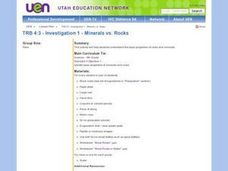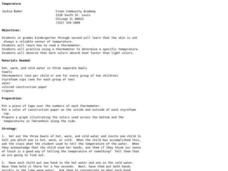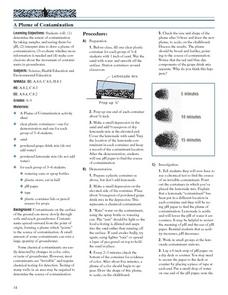Curated OER
Demonstration of Factors Affecting Soil Temperature
Learners examine the influences of water and mulch on soil temperature. For this investigative activity students complete a soil experiment.
Curated OER
Egg-sceptional
Students design colored Easter eggs in this simple Art lesson for the elementary classroom. The dye is created using almost boiling water and should be done by the teacher. This lesson is ideal for the spring-time months and includes...
Curated OER
The Country of Chile - Map Work
In this map worksheet, students label a map of Chile by following 11 directions given at the bottom of the page. They label landforms and water bodies associated with the country.
Curated OER
Minerals vs. Rocks
Fourth graders are introduced to the characteristics of a variety of minerals and rocks. As a class, they are shown rocks and minerals and asked to describe them as a geologist would. They work together to measure and record their...
Curated OER
Temperature
Students explore hot, warm, and cold. In this temperature lesson, students use thermometers to find specific temperatures. Students also consider how colored items absorb heat as they participate in a demonstration.
Curated OER
Exploring the Map of Morocco
In this exploring the map of Morocco worksheet, students find and label cities, islands, bodies of water, mountains, deserts and other countries around Morocco.
Curated OER
Weathering Landforms
Fifth graders brainstorm a list of ways the Earth's surface can change. As a class, they are introduced to the concepts of erosion and weathering and discover how wind and water cause changes to the surface of the Earth. To end the...
Curated OER
Liquids in Bottles
Students investigate different liquids to develop their concept of a liquid. They work at a center to tip, swirl, shake, roll, and otherwise investigate seven liquids in small, clear plastic bottles: plain water, corn syrup, liquid...
Curated OER
Making Molecules
In this molecules worksheet, students combine different food colorings that represent atoms to make different molecules. Students read 7 directions and answer 2 questions.
Curated OER
Changing Matter
Fifth graders conduct an experiment. In this changing matter lesson plan, 5th graders receive a cup of crystals, record their observations, add water to the crystals and record new observations. Students then discuss the differences...
Curated OER
Bivalve Biology
Students place clams into a beaker containing saltwater. They place a small drop of food coloring just above the shell. Students observe the movement of the food coloring. Clams are then placed into clean beakers of saltwater with 24...
Curated OER
Creating a Map of France
In this crating a map of France learning exercise, students find and label important parts of France, bodies of water, mountains and surrounding countries.
Curated OER
Sea Ice
Students observe the freezing times and temperatures of water with varying levels of salinity. They determine how icebergs form, how they act, and what they may be made of. They discover that salinity level affects the time it takes...
Curated OER
Aquarium Crayon Resist
Students create a crayon resist drawing as a literature response. In this literature response and art lesson, students listen to the book, Rainbow Fish, noting all of the colorful fish. They use wax crayons to draw a picture of a fish...
Curated OER
Observing Buffers In Lakes, Ponds And Streams
Young scholars observe the effects of limestone on the acidity of water. Some areas of the nation have a lot of limestone in lake bottoms and in soil, which helps neutralize the effects of acid rain. Students see this effect first hand.
Curated OER
Processes of the Rock Cycle
Students explore, predict, and create each major rock form (sedimentary, metamorphic, and igneous) with colored modeling clay, discover cycle of rock formation, and examine important relationships of heat and pressure in rock development.
T. Smith Publishing
Counting Fish
Individuals examine a picture of children standing on a bridge over a fish pond. They count the fish and write a number to represent how many are in the water. Cute, simple, and to the point. Note, however, that there is only one problem...
Curated OER
Monitoring River Levels
For this environmental science worksheet, learners read and study water maps from an interactive website to complete 8 short answer questions that follow.
Curated OER
Down the Drain
Students explore what problems might occur if oxygen decreases in a body of water. They model what happens in a situation where decomposition is occurring. Students obtain, organize, graph, and interpret information. They i interpret...
Curated OER
Food Chains And Webs
Learners investigate the concept of soil and all its components. They collect samples from a local site and transplant it into a terrarium. Students identify the organic elements, clay ,silt, and other forms of debris. They also identify...
Curated OER
Permafrost: Permanently Frozen Ground
Students explore permafrost. In this 3 states of matter lesson, students identify characteristics of solids and liquids. Students observe water and soil melting and freezing at various temperatures. Students make predictions about a...
Curated OER
Changing Places
This lesson involves live ladybugs. Students view two containers of water and take the temperature of each. They construct a graph on chart paper to compare the two containers. Students speculate which water sample the ladybugs will like...
Curated OER
A Plume of Contamination
Students perform an experiment/investigative simulation regarding the movement of contaminants in groundwater. They test the pH of three water samples, and then use their reasoning skills to determine the source of an invisible...
Curated OER
Floating Pencil
Students discover how salt water makes a pencil float better than freshwater by measuring and comparing the lengths of the portion of the pencil that floats above the water surface. They then determine if an unknown water sample is...

























